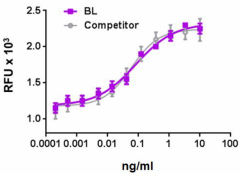- Regulatory Status
- RUO
- Other Names
- Catabolin, interleukin-1 beta, preinterleukin 1 beta, pro-interleukin-1-beta, IL-1b

-

Recombinant Rat IL-1β induces the proliferation of mouse D10.G4.1 cell line in a dose dependent manner. BioLegend’s protein was compared side-by-side to a competitor’s equivalent product.
| Cat # | Size | Price | Quantity Check Availability | ||
|---|---|---|---|---|---|
| 750502 | 10 µg | $218.00 | |||
| 750504 | 25 µg | $405.00 | |||
| 750506 | 100 µg | $1167.00 | |||
Select size of product is eligible for a 40% discount! Promotion valid until December 31, 2024. Exclusions apply. To view full promotion terms and conditions or to contact your local BioLegend representative to receive a quote, visit our webpage.
IL-1β does not encode a typical signal peptide. As a result, newly synthesized pro-IL-1β accumulates within the cytoplasm of activated monocytes and macrophages. The conversion of the inactive pro-IL-1β to its mature form requires the proteolytic action from the IL-1β-converting enzyme (ICE), which is also termed as caspase-1. Secretion of mature IL-1β from LPS-activated monocytes/macrophages is not a constitutive process. These cells must encounter a secondary stimulus that specifically activates the post-translational processing events. Moreover, owing to its pro-inflammatory nature, IL-1β is considered a tumor-promoting cytokine. In fact, enhanced tumor metastasis and angiogenesis have been observed under the influence of IL-1β. IL-1β is able to facilitate tumor progression in murine models of lung cancer. Additionally, the promotion of metastasis and tumor angiogenesis by IL-1β have been associated with increased activity of matrix metalloproteinases and expression of the pro-angiogenic molecule hepatocyte growth factor. IL-1β plays a pathogenic role in Type 1 and Type 2 diabetes, rheumatoid arthritis, and osteoarthritis among other diseases.
Product Details
- Source
- Rat IL-1β, amino acids Met-(Val 117-Ser268) (Accession# NM_031512), was expressed in E. coli.
- Molecular Mass
- The 153 amino acid recombinant protein has a predicted molecular mass of approximately 17.4 kD. The DTT-reduced and non-reduced protein migrates at approximately 18 kD by SDS-PAGE. The predicted N-terminal amino acid is Met.
- Purity
- >95%, as determined by Coomassie stained SDS-PAGE.
- Formulation
- 0.22 µm filtered protein solution is in PBS, pH 7.2.
- Endotoxin Level
- Less than 0.01 ng per µg cytokine as determined by the LAL method.
- Concentration
- 10 and 25 µg sizes are bottled at 200 µg/mL. 100 µg size and larger sizes are lot-specific and bottled at the concentration indicated on the vial. To obtain lot-specific concentration and expiration, please enter the lot number in our Certificate of Analysis online tool.
- Storage & Handling
- Unopened vial can be stored between 2°C and 8°C for up to 2 weeks, at -20°C for up to six months, or at -70°C or colder until the expiration date. For maximum results, quick spin vial prior to opening. The protein can be aliquoted and stored at -20°C or colder. Stock solutions can also be prepared at 50 - 100 µg/mL in appropriate sterile buffer, carrier protein such as 0.2 - 1% BSA or HSA can be added when preparing the stock solution. Aliquots can be stored between 2°C and 8°C for up to one week and stored at -20°C or colder for up to 3 months. Avoid repeated freeze/thaw cycles.
- Activity
- Rat IL-1β induces the proliferation of D10.G4.1 mouse helper lymphocytes in a dose-dependent manner. The ED50 = 0.05 - 0.25 ng/mL.
- Application
-
Bioassay
- Application Notes
-
BioLegend carrier-free recombinant proteins provided in liquid format are shipped on blue-ice. Our comparison testing data indicates that when handled and stored as recommended, the liquid format has equal or better stability and shelf-life compared to commercially available lyophilized proteins after reconstitution. Our liquid proteins are verified in-house to maintain activity after shipping on blue ice and are backed by our 100% satisfaction guarantee. If you have any concerns, contact us at tech@biolegend.com.
Antigen Details
- Structure
- Cytokine.
- Distribution
-
IL-1β is produced by monocytes, macrophages, microglia, keratinocytes, stimulated B lymphocytes, fibroblasts, endothelial cells, and epithelial cells. Mononuclear cells secrete the highest levels of IL-1β.
- Function
- IL-1β is a cytokine with a key role in the pathophysiology of local and systemic inflammation. IL-1β induces cytokine, chemokine, proinflammatory molecule secretion, and adhesion molecule expression in diverse cells. IL-1β is induced by high concentrations of glucose, free fatty acids, and leptin in pancreatic beta cells. IL-1R antagonist binds to IL-1R type I without inducing a response, which blocks the binding of IL-1β to the receptor.
- Interaction
- Multiple cells.
- Ligand/Receptor
- Type I and II IL-1 receptors (IL-1RI and IL-RIII).
- Cell Type
- Hematopoietic stem and progenitors
- Biology Area
- Cell Biology, Immunology, Innate Immunity, Neuroinflammation, Neuroscience, Stem Cells
- Molecular Family
- Cytokines/Chemokines
- Antigen References
-
1. Stevenson FT, et al. 1992. J. Cell Physiol. 152:223.
2. Shi J, et al. 2007. J. Immunol. 179:1245.
3. Dinarello CA. 2006. Cancer Metastasis Rev. 25:307.
4. Boost KM, et al. 2008. BMC Cancer 8:265.
5. Dinarello CA. 2011. J. Internal Med. 269:16. - Gene ID
- 24494 View all products for this Gene ID
- UniProt
- View information about IL-1beta on UniProt.org
